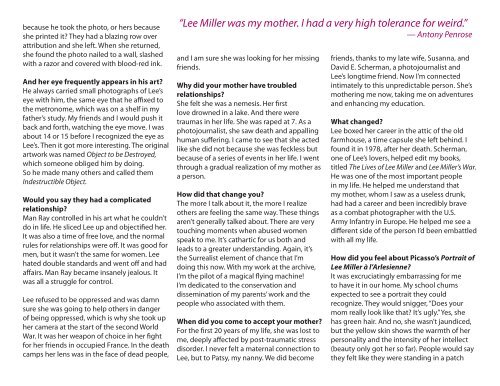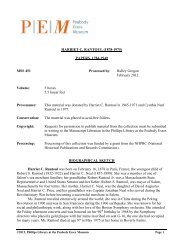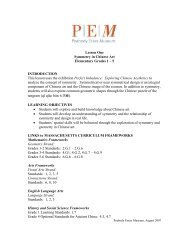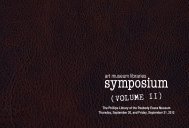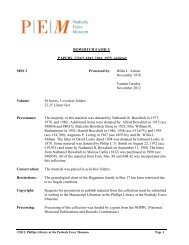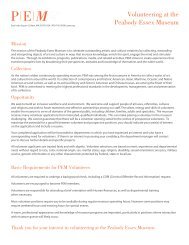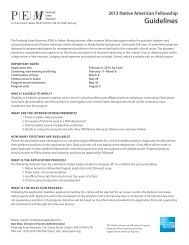Interview with Antony Penrose - Peabody Essex Museum
Interview with Antony Penrose - Peabody Essex Museum
Interview with Antony Penrose - Peabody Essex Museum
Create successful ePaper yourself
Turn your PDF publications into a flip-book with our unique Google optimized e-Paper software.
ecause he took the photo, or hers because<br />
she printed it They had a blazing row over<br />
attribution and she left. When she returned,<br />
she found the photo nailed to a wall, slashed<br />
<strong>with</strong> a razor and covered <strong>with</strong> blood-red ink.<br />
And her eye frequently appears in his art<br />
He always carried small photographs of Lee’s<br />
eye <strong>with</strong> him, the same eye that he affixed to<br />
the metronome, which was on a shelf in my<br />
father’s study. My friends and I would push it<br />
back and forth, watching the eye move. I was<br />
about 14 or 15 before I recognized the eye as<br />
Lee’s. Then it got more interesting. The original<br />
artwork was named Object to be Destroyed,<br />
which someone obliged him by doing.<br />
So he made many others and called them<br />
Indestructible Object.<br />
Would you say they had a complicated<br />
relationship<br />
Man Ray controlled in his art what he couldn’t<br />
do in life. He sliced Lee up and objectified her.<br />
It was also a time of free love, and the normal<br />
rules for relationships were off. It was good for<br />
men, but it wasn’t the same for women. Lee<br />
hated double standards and went off and had<br />
affairs. Man Ray became insanely jealous. It<br />
was all a struggle for control.<br />
Lee refused to be oppressed and was damn<br />
sure she was going to help others in danger<br />
of being oppressed, which is why she took up<br />
her camera at the start of the second World<br />
War. It was her weapon of choice in her fight<br />
for her friends in occupied France. In the death<br />
camps her lens was in the face of dead people,<br />
“Lee Miller was my mother. I had a very high tolerance for weird.”<br />
— <strong>Antony</strong> <strong>Penrose</strong><br />
and I am sure she was looking for her missing<br />
friends.<br />
Why did your mother have troubled<br />
relationships<br />
She felt she was a nemesis. Her first<br />
love drowned in a lake. And there were<br />
traumas in her life. She was raped at 7. As a<br />
photojournalist, she saw death and appalling<br />
human suffering. I came to see that she acted<br />
like she did not because she was feckless but<br />
because of a series of events in her life. I went<br />
through a gradual realization of my mother as<br />
a person.<br />
How did that change you<br />
The more I talk about it, the more I realize<br />
others are feeling the same way. These things<br />
aren’t generally talked about. There are very<br />
touching moments when abused women<br />
speak to me. It’s cathartic for us both and<br />
leads to a greater understanding. Again, it’s<br />
the Surrealist element of chance that I’m<br />
doing this now. With my work at the archive,<br />
I’m the pilot of a magical flying machine!<br />
I’m dedicated to the conservation and<br />
dissemination of my parents’ work and the<br />
people who associated <strong>with</strong> them.<br />
When did you come to accept your mother<br />
For the first 20 years of my life, she was lost to<br />
me, deeply affected by post-traumatic stress<br />
disorder. I never felt a maternal connection to<br />
Lee, but to Patsy, my nanny. We did become<br />
friends, thanks to my late wife, Susanna, and<br />
David E. Scherman, a photojournalist and<br />
Lee’s longtime friend. Now I’m connected<br />
intimately to this unpredictable person. She’s<br />
mothering me now, taking me on adventures<br />
and enhancing my education.<br />
What changed<br />
Lee boxed her career in the attic of the old<br />
farmhouse, a time capsule she left behind. I<br />
found it in 1978, after her death. Scherman,<br />
one of Lee’s lovers, helped edit my books,<br />
titled The Lives of Lee Miller and Lee Miller’s War.<br />
He was one of the most important people<br />
in my life. He helped me understand that<br />
my mother, whom I saw as a useless drunk,<br />
had had a career and been incredibly brave<br />
as a combat photographer <strong>with</strong> the U.S.<br />
Army Infantry in Europe. He helped me see a<br />
different side of the person I’d been embattled<br />
<strong>with</strong> all my life.<br />
How did you feel about Picasso’s Portrait of<br />
Lee Miller à l’Arlesienne<br />
It was excruciatingly embarrassing for me<br />
to have it in our home. My school chums<br />
expected to see a portrait they could<br />
recognize. They would snigger, “Does your<br />
mom really look like that It’s ugly.” Yes, she<br />
has green hair. And no, she wasn’t jaundiced,<br />
but the yellow skin shows the warmth of her<br />
personality and the intensity of her intellect<br />
(beauty only got her so far). People would say<br />
they felt like they were standing in a patch


